pBD-PYR1
(Plasmid
#241278)
-
PurposeYeast two hybrid vector expressing BD-PYR1 (wild type)
-
Depositing Lab
-
Sequence Information
Ordering
| Item | Catalog # | Description | Quantity | Price (USD) | |
|---|---|---|---|---|---|
| Plasmid | 241278 | Standard format: Plasmid sent in bacteria as agar stab | 1 | $89 | |
Backbone
-
Vector backbonepBD-GAL4-cam
-
Vector typeYeast Expression
Growth in Bacteria
-
Bacterial Resistance(s)Chloramphenicol, 25 μg/mL
-
Growth Temperature37°C
-
Growth Strain(s)DH5alpha
-
Copy numberHigh Copy
Gene/Insert
-
Gene/Insert namePYR1
-
SpeciesA. thaliana (mustard weed)
-
MutationNA
-
Entrez GenePYR1 (a.k.a. AT4G17870, PYRABACTIN RESISTANCE 1, RCAR11, T6K21.50, T6K21_50, regulatory component of ABA receptor 11)
Cloning Information
- Cloning method Restriction Enzyme
- 5′ cloning site Unknown (unknown if destroyed)
Terms and Licenses
-
Academic/Nonprofit Terms
-
Industry Terms
- Not Available to Industry
Trademarks:
- Zeocin® is an InvivoGen trademark.
Depositor Comments
Cutler lab uses this with yeast strain Mav99 but has tested it with Mav203 (commercially available) and it works well with that strain too. Please visit https://doi.org/10.1101/2025.05.15.654352 for bioRxiv preprint.
These plasmids were created by your colleagues. Please acknowledge the Principal Investigator, cite the article in which the plasmids were described, and include Addgene in the Materials and Methods of your future publications.
-
For your Materials & Methods section:
pBD-PYR1 was a gift from Sean Cutler (Addgene plasmid # 241278 ; http://n2t.net/addgene:241278 ; RRID:Addgene_241278) -
For your References section:
Abscisic acid inhibits type 2C protein phosphatases via the PYR/PYL family of START proteins. Park SY, Fung P, Nishimura N, Jensen DR, Fujii H, Zhao Y, Lumba S, Santiago J, Rodrigues A, Chow TF, Alfred SE, Bonetta D, Finkelstein R, Provart NJ, Desveaux D, Rodriguez PL, McCourt P, Zhu JK, Schroeder JI, Volkman BF, Cutler SR. Science. 2009 May 22;324(5930):1068-71. doi: 10.1126/science.1173041. Epub 2009 Apr 30. 10.1126/science.1173041 PubMed 19407142



